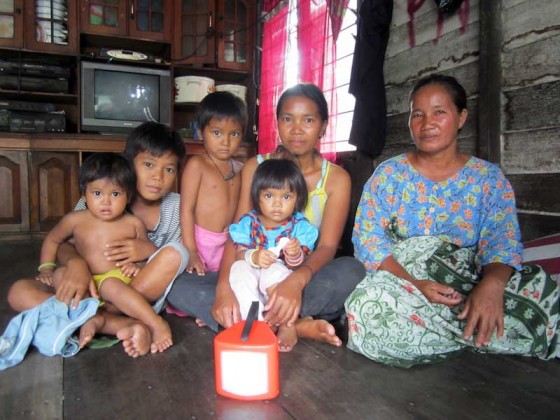
I’ve been conducting my impact assessment of d.light S250 solar lanterns in Galinggang for six weeks now. When we think about solar lanterns, we naturally think about how the light that they produce can help the people in the village. The purpose of a solar lantern is to emit light. Therefore the light produced is the direct benefit of purchasing the lantern.
BUT IS THERE MORE THAN THAT?
I visited the house of Nanai and her husband Barak one day, to interview the family. There are eight people living in the house: Barak, Nanai, their oldest daughter Fatmawati, Fatmawati’s children Amel and Ardi, and three of Fatmawati’s younger siblings. Before purchasing their solar lantern, Fatmawati and her family used six kerosene lamps each night. The kerosene lamps were expensive, and hazardous. Now, with the solar lantern, the family only uses one kerosene lamp each night for supplementary light. They no longer worry so much about kerosene smoke, or about the possibility of fire if the kerosene lamps fall.
The fact that one solar lantern replaces five kerosene lamps triggered my curiosity about the money that they can save from buying far less kerosene. Losing five kerosene lamps must mean something for the family.
“YOU MUST HAVE SOME EXTRA SAVINGS BECAUSE YOU DON’T HAVE TO BUY AS MUCH KEROSENE AS BEFORE, RIGHT? WHAT DO YOU SPEND THE MONEY ON?” I ASKED FATMAWATI.
Fatmawati just smiled, and turned her head to Amel, her youngest daughter. Amel was drinking milk from her baby’s bottle, tranquilly sitting and staring at me with her big eyes.
“THAT,” FATMAWATI ANSWERED.
“WHAT’S THAT?” I WAS CONFUSED.
“THAT. MILK. I CAN BUY AMEL MILK NOW.”
For some of us, there is nothing remarkable about buying milk. However, for Fatmawati, her decision to purchase a solar lantern means she can afford milk for her daughter.
“YOU NEVER BOUGHT AMEL MILK BEFORE PURCHASING THE SOLAR LANTERN?” I ASKED.
“NEVER. AMEL STARTED DRINKING MILK IN MARCH, WHEN I BOUGHT THE SOLAR LANTERN,” FATMAWATI ANSWERED WITH A BIG SMILE ON HER FACE.
I sensed accomplishment and relief from Fatmawati. She seemed very happy and, probably, felt complete as a mother who now is able to afford what her daughter needs. She knew she had done something right. Amel was still sitting right beside her mother, drinking milk while listening to the interview.
There are many other households which are able to save more money now, thanks to the solar lanterns, which replace one or more kerosene lamps. The reduced purchase of kerosene (and also batteries for flashlight) allows people to spend their money on more urgent and more important needs.
Just like Amel’s milk.


